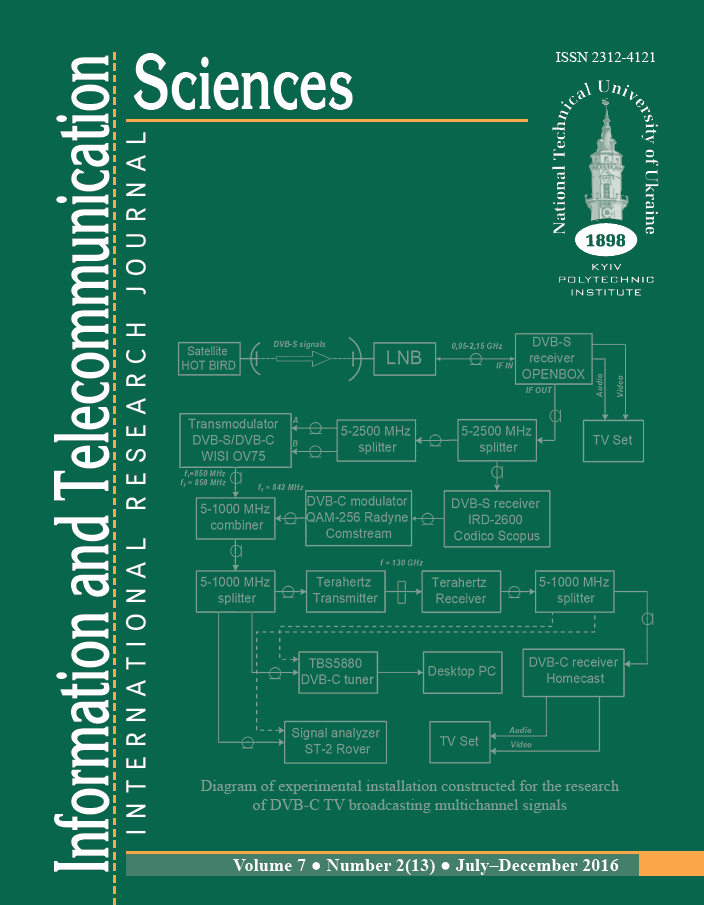DEPENDENCE OF NANOCOMPOSITE SYSTEM “GLASS -Pb2Ru2O6; RuO2" ELECTROPHYSICAL PARAMETERS ON PROPERTIES OF A GLASS AND STRUCTURALLY-PHASE TRANSFORMATIONS
DOI:
https://doi.org/10.20535/2411-2976.22016.5-9Keywords:
nanocomposite heterophase system “glass- Pb2Ru2O6, RuO2”, structural-phase transformations, electrophysical parametersAbstract
Background. Electrophysical parameters (EPhP) of hybrid integrated circuits (HIC) thick-film elements or sensor sensitive elements which are formed from “glass - ”Pb2Ru2O6; RuO2" heterophase systems on the given time are characterized by low reproducibility and significant instability. The degradation of thick-film elements characteristics is another problem.
Objective. The aim of the paper is to establish the influence on EPhP glass properties as nanocomposite binding agent, structural-phase transformations and mechanisms of electric conductivity.
Methods. Heat treatment of nanocomposites of different structure and their X-ray structure analysis were carried out. Changing of EPhP of films from nanocomposites of different structure, and also factor of linear thermal expansion depending on external factors were determined.
Results. Influence of glass properties and structural-phase transformations in nanocomposite systems “glass - Pb2Ru2O6,RuO2” were established at their annealing. A principal cause of lead ruthenate decomposition and dioxide ruthenium formation is not thermal dissociation of initial current-carrying phase, but chemical reaction at interaction between Pb2Ru2O7-x and glass binding components. It is the consequence of stronger acid properties of binding metal oxides, in particular, boron oxide. Dependence of percentage content, in particular, a current-carrying phase on B2O3 concentration in constant binding
are established.
Conclusions. The big content of boron oxide and glass high acidity is a principal cause of chemical decomposition of lead ruthenite and formation of dioxide ruthenium at “glass - Pb2Ru2O6, RuO2” nanocomposite systems annealing.
The increase of investigated system nanocomposite layers conduction, at contents of a current-carrying phase increase it is possible to explain by percolating transition owing to occurrence of conducting phase cluster in matrix structure.
References
Grebyonkina VG Dobroier VS Panov LI, JP Funeral feast Thick mikroelektronika.- Naukova Dumka, 1983. (in Russian).
Ya.I. Lepikh, T.I. Lavrenova, T.N. Bugayova., N.P. Zatovskaya, P.O. Snigur. Annealing temperature modes influence on properties of heterophase nanocomposites based on ceramics “glass - Ag-Pd” systems. J. Functional Materials.- vol. 21.- No. 3 (2014). - PP. 297-
Ya.I. Lepikh, T.I. Lavrenova. Model of α-SiO2 crystal phase in a glass matrix concentration influence on "glass - RuO2" nanocomposite specific resistance // Materials of allukrainian conference with the
international participation "Surface of Chemistry, Physics and Technology" and seminar“ Nanostractured biosuperpose bioactive materials". - Kiev, May, 13-15, 2015. – P. 143. (In Ukrainean).
Lepikh Ya.I., Lavrenova T.I., Bugayova T.M, Lenkov S.V. Influence of the particle geometrical sizes and proportion of the initial components concentration on electrophysical parameters of heterophase nanocomposites on "glass - RuO2" base // Collection of Scientific Works of Military Institute of the T. Shevchenko Kiev National University (MIKNU).- 2013.- PP. 53-58.
The patent of Ukraine for Useful model № 103231 "Glass binding agent for nanocomposites based on system "glass - metal - oxides" // Ya.I. Lepikh, T.I. Lavrenova. Publ. 10.12.2015, Bul. № 23.

